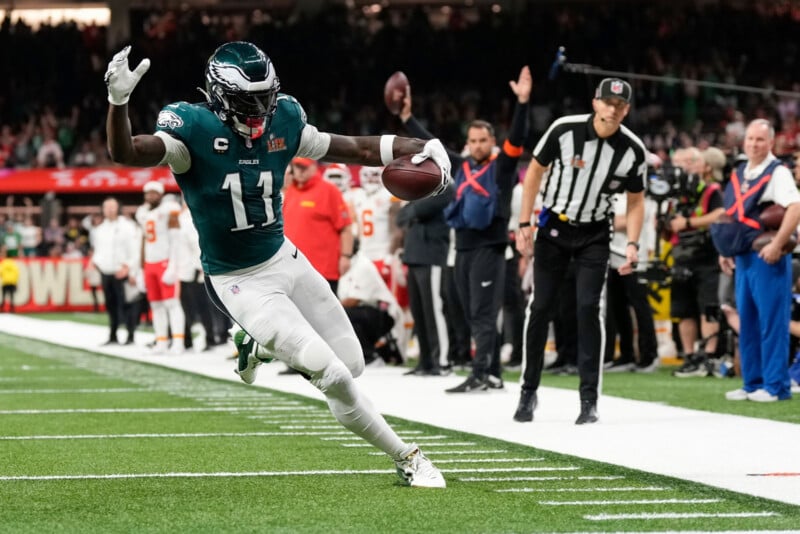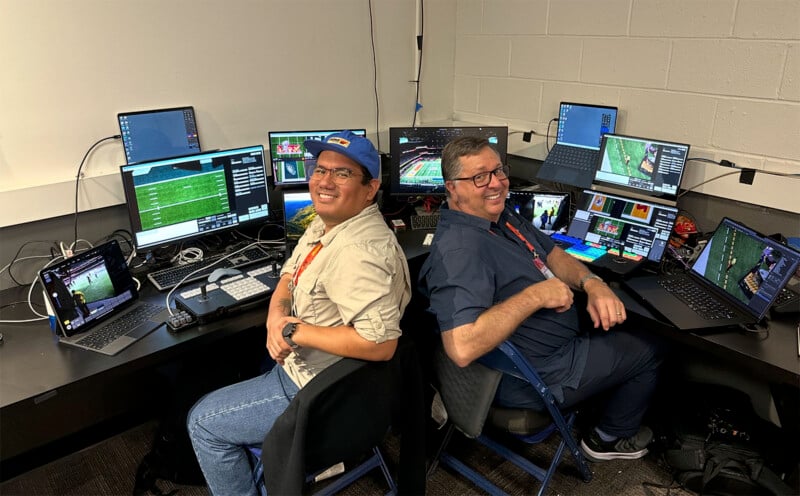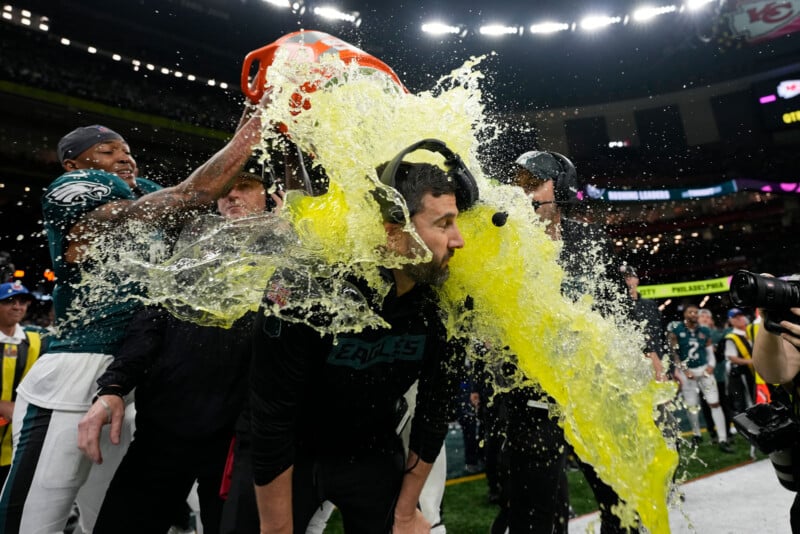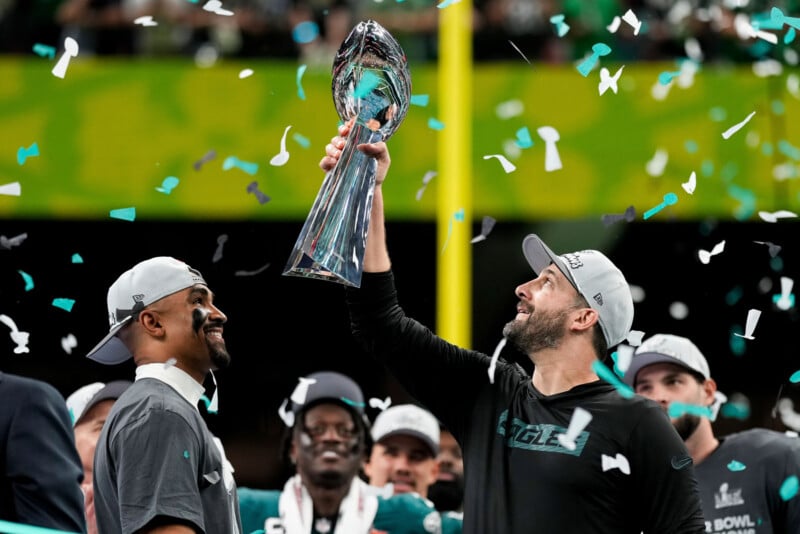How AP Photographers Captured the Iconic Moments of Super Bowl LIX
![]()
The Philadelphia Eagles dominated the Kansas City Chiefs at the Caesars Superdome in New Orleans, winning Super Bowl LIX and lifting the Vince Lombardi trophy. The Associated Press (AP) was on hand in full force with its Sony cameras and lenses to document everything, and PetaPixel chatted with the AP to learn more about how it photographs the biggest sporting event of the year.
PetaPixel spoke with Stephanie Mullen, AP’s Deputy Director of Photography, and photographer Chris Carlson, who leads the AP’s NFL coverage. They are both veterans of the AP and sports coverage alike. Mullen will have been with the AP for 30 years come June and she has covered about 15 Super Bowls during that time.
Carlson works with Mullen to oversee the AP’s coverage of many prominent national sporting events, and as part of that, he has been coordinating the AP’s NFL work for the past three seasons. The NFL season is much longer for AP photographers than it might seem, as they must cover the lead-up to the draft, including pro days and the combine, plus off-season workouts, training camps, and more. It’s nearly a 12-month endeavor. He will begin preparing for the next Super Bowl this week; the dust never settles.

The Associated Press’ Evolving Super Bowl Coverage
Although Super Bowl LIX is the AP’s biggest sports event on the calendar in 2025, requiring the most people and the greatest coordination for any sporting event, the AP has shrunk its Super Bowl team in recent years.
“I covered the Super Bowl for the AP many years when the number of photographers would push closer to 15, sometimes 20 photographers,” Mullen says over the phone from a hotel lobby in New Orleans the day before the big game. “We were just absolutely saturated on the field and in the stands.”
Mullen says that she and the rest of the team studied the shots they were getting from all these photographers and found that the AP’s coverage was less successful with all those photographers.
“So we started to dial it back until we found this sweet spot that we’re at now that Chris [Carlson] is responsible for,” Mullen says.
“It’s literally the magic number of people that we have on the field so that every photographer feels both that sense of responsibility to what’s in front of them, but also that comfort of knowing that they have colleagues in just the right positions around them to back them up for whatever plays are happening in their little quadrant of the field,” she continues.

Mullen argues that the situation felt a little too relaxing when the team was larger. It is not that Mullen and Carlson want their team to feel stressed — quite the opposite — but they needed to find the right balance of intensity to get the best work out of everyone.
Carlson adds that there have also been practical concerns. When COVID hit, access was significantly limited and, in some respects, never fully opened back up. However, the AP is the only agency with seven photographers on the field during the Super Bowl, which Carlson says is because of the AP’s relationship with the NFL.
“We’re fortunate to have that amount of coverage,” he says.
Beyond these seven photographers, the AP puts a couple of photographers elevated above each end zone, plus one higher up near the 50-yard line.
This midfield position is excellent for covering the halftime show, a newer focus for the AP.
“We’re sports photographers and part of the day, we’re entertainment photographers, and that’s very new in the last couple of years. So choosing the positions and who comes to shoot those positions, Chris has to factor in that person’s understanding of and success with entertainment stories,” Mullen explains.
Mullen and Carlson must also consider the halftime show when installing their robotic cameras. Like the rest of the AP’s camera equipment, the robotic cameras are Sony models and controlled using Sony software.
“We’re currently putting [robotic cameras] in the end zones so we can cover both ends of the fields. We have a robotic in one end zone and a robotic in the other,” explains Carlson.

There are also robotic cameras at midfield and one in each team’s tunnel from the locker room. He had hoped the team could install one over the field from the catwalk, but there were so many lighting and wiring components for the halftime show that it wasn’t possible.
These robotic cameras are manually controlled by two people who set up a robotic camera control area in the AP’s workspace. They split the duties between them and are able to control each camera and nail the perfect shot. They also control seven static cameras that are pointed at different key areas on the field, including where the logos are painted.
“If Patrick Mahomes throws over the Super Bowl LIX logo, we’ll have it. If Kelce catches a touchdown pass over the Chief’s logo, we’ll have that,” says Carlson. “So those things are something that we know that that’s going to be an interesting photograph and a unique angle and we can set up a static camera for that.”

![]()
One of the robotic camera operators is David Phillip, an AP robotic camera vet. Mullen says Philip has been one of the AP’s pioneers for robotic camera technology. The AP also wants to ensure it continually folds in young photographers, so Philip was joined for this year’s Super Bowl by Godofredo Vasquez.
Nailing the Shot Requires the Right People Being Given All the Tools They Require
As any sports fan knows, sports are unpredictable. This is why having the right photographers on hand and giving them all the opportunities to succeed is so important. The difference between the perfect frame and a dud is agonizingly tiny — it can and often does come down to a millisecond one way or the other.
Mullen and Carlson do everything in their power to give each of their photographers the best chance for success, and that starts with choosing who covers the event in the first place.
“We decide who comes to these games based on what we have seen [from them] throughout the season, who is really paying attention to the games, who has the nuances, who is looking for those subtle pictures,” Mullen tells PetaPixel.

“The key to success is the team you bring here, and the photography they have provided since August gets us to the Super Bowl and sets us up for success. [Our] photographers know what to look for,” she adds.
The AP also brings the photographers who have covered the teams in the Super Bowl all season, so in this case, the two people who were shooting the Kansas City Chiefs and the Philadelphia Eagles.
Their “local knowledge” is super helpful for the rest of the team, as they can offer insights about what to look for and what certain players are likely to do in different situations. When the margin between success and failure is so thin and so important, every little advantage matters.
“To give you a sense of the basic setup, we have four photographers that each get a quarter [of the field], so they’ll get a corner and they’re watching from the goalpost up the sideline,” Carlson explains. “The other people can look elsewhere, they can look at the coach, the bench.”
There are also photographers on each side of the field who follow the ball and go up and down the field.
“If there’s a fumble that’s recovered and run back, we’ll have somebody there on that side to catch it. The idea is that no part of the field is left uncovered. If something happens on the field, we’ll get it from the right side.”

What Makes the Best Super Bowl Photo?
The Super Bowl is unique because not only does it provide incredible moments of athleticism and plenty of fodder for amazing action photographs but it also includes moments of extreme emotion. The joys of victory necessarily come with the pain of defeat, and for Mullen, a great sports photo includes both in a single frame.
“I love a picture that shows you the winners and the losers and the agony and the joy all in one photo. So if I am forced to pick a storytelling frame, that’s where I would lean,” Mullen says.
“Of course, you could always justify very important plays that turn the game or something like that. But for me it’s that I love the step back wider beautiful picture that has that sense of place. You’re in a beautiful venue. You’ve captured the joy of the fans and the people who’ve committed time and money to come and support this game. And if you can do that while showing both joy and agony, those are my favorite pictures.”
As for Carlson, the perfect sports photo is the one that people want to see — the one that stands out from the rest and encapsulates the game. It’s less about the ingredients and more about the result, although the ideas are undoubtedly intertwined.
“We used to say that when you’re at the Super Bowl, you’re shooting for the front page. That maybe is a little antiquated now, but the concept is probably the same,” Carlson says.
“You’re looking for that one picture that everybody — when they’re choosing from the thousands that are out there — that’s the one picture that everybody stops at and says, ‘This is the picture that we have to have on our front page today.’ And I think every photographer out there tomorrow wants to shoot that picture.”

Building the Perfect Team to Capture the Front Page Photo
Mullen and Carlson give their carefully selected photographers the tools they need to succeed. Just as importantly, they have built a safety net through organization and preparation that ensures each photographer is in a position where they get the photographs they need and are free to adapt on the fly and be creative. After all, the photographers selected to cover the Super Bowl were picked because they have shown this ability to consistently do what is required with eye-catching creativity.
“I’m really confident with this team, and I know we’re going to have a beautiful report and we’re going to provide speedy, high-quality content to our customers,” Mullen says. “I think at the end of the day, if we walk away capturing the essence of this game, the joy and the big plays, this will be a success.”
Based on what the AP’s photographers captured, it was a smashing success.
“People can parachute in and look at our work room and think, ‘Oh wow, covering a football game, you’re just covering a football game,'” Mullen adds. “But the hard work is in the weeks and months that get us to this point and all the work that gets this room prepared, that gets this team prepared. I have so much confidence in this group and our choices.”
Agreeing, Carlson adds that he wants his team to win.
“I want to win the play, I want to see our pictures on the front of our every website and the front of every newspaper on Monday.”
“Everyone here has been put in the position to succeed, so they will. They’re here because they’re good at what they do. They work well together as a team. They like each other, they trust each other,” he affirms.
“At the end of the day, we’ll have what we need. I’m not at all nervous about that. Everything else that goes after is just gravy.”
“That’s how you foster creativity,” Mullen concludes. “You make sure that photographers know that that creative brain needs some room, and with that comes the risk of failure, and we’re right here behind them. If that creative idea didn’t pan out, we’re right here to help you pick up the pieces and figure out the next approach or the next one. And that’s really important.”
Each Super Bowl is a learning experience for Mullen and Carlson. There are always new ideas to try, and their work for historic Super Bowl LX next season at Levi’s Stadium in Santa Clara, California, will begin this week. When trying to be the absolute best you can be, there is no off-season.
Image credits: Photographs provided by Associated Press. Individual photographers are credited in the image captions.